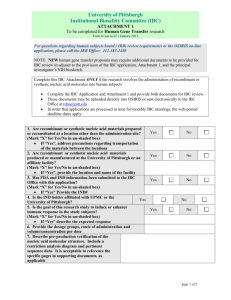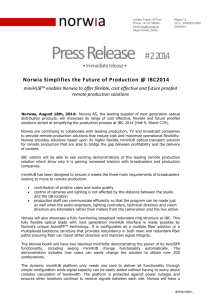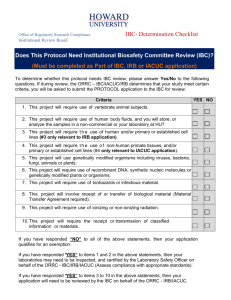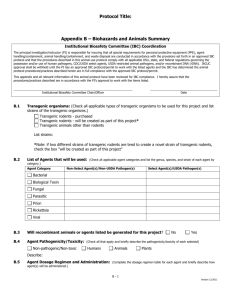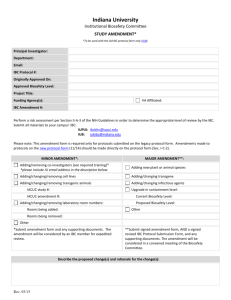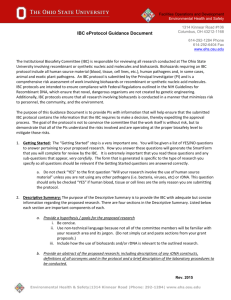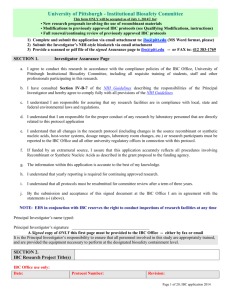IBC Charter 9-21-15
advertisement
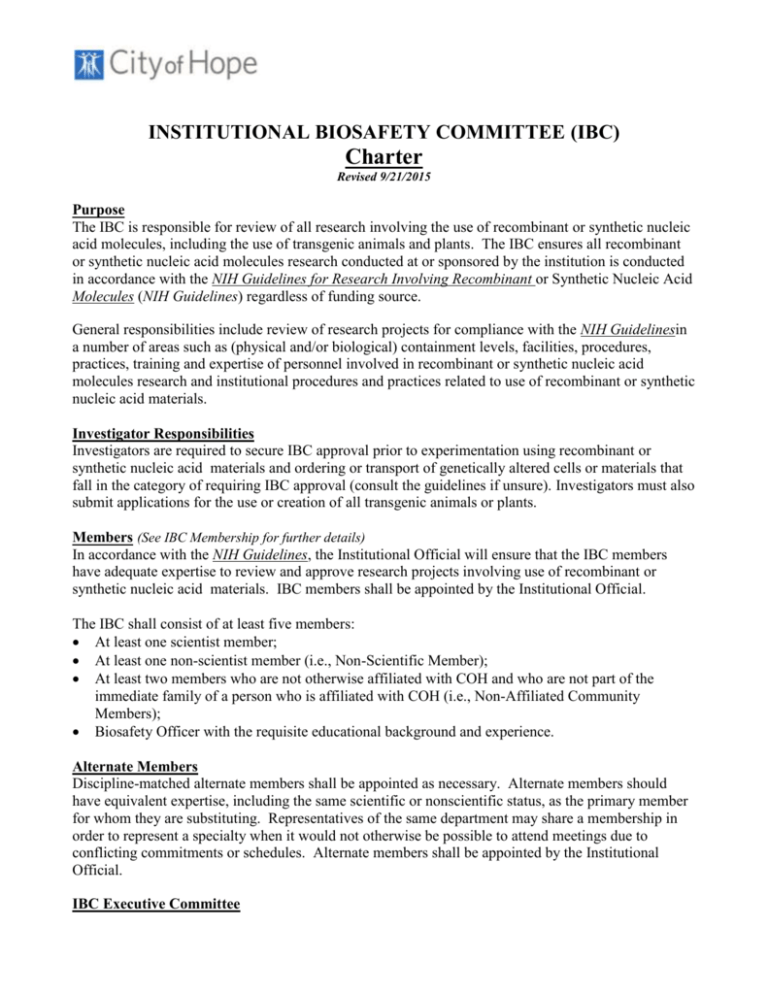
INSTITUTIONAL BIOSAFETY COMMITTEE (IBC) Charter Revised 9/21/2015 Purpose The IBC is responsible for review of all research involving the use of recombinant or synthetic nucleic acid molecules, including the use of transgenic animals and plants. The IBC ensures all recombinant or synthetic nucleic acid molecules research conducted at or sponsored by the institution is conducted in accordance with the NIH Guidelines for Research Involving Recombinant or Synthetic Nucleic Acid Molecules (NIH Guidelines) regardless of funding source. General responsibilities include review of research projects for compliance with the NIH Guidelinesin a number of areas such as (physical and/or biological) containment levels, facilities, procedures, practices, training and expertise of personnel involved in recombinant or synthetic nucleic acid molecules research and institutional procedures and practices related to use of recombinant or synthetic nucleic acid materials. Investigator Responsibilities Investigators are required to secure IBC approval prior to experimentation using recombinant or synthetic nucleic acid materials and ordering or transport of genetically altered cells or materials that fall in the category of requiring IBC approval (consult the guidelines if unsure). Investigators must also submit applications for the use or creation of all transgenic animals or plants. Members (See IBC Membership for further details) In accordance with the NIH Guidelines, the Institutional Official will ensure that the IBC members have adequate expertise to review and approve research projects involving use of recombinant or synthetic nucleic acid materials. IBC members shall be appointed by the Institutional Official. The IBC shall consist of at least five members: At least one scientist member; At least one non-scientist member (i.e., Non-Scientific Member); At least two members who are not otherwise affiliated with COH and who are not part of the immediate family of a person who is affiliated with COH (i.e., Non-Affiliated Community Members); Biosafety Officer with the requisite educational background and experience. Alternate Members Discipline-matched alternate members shall be appointed as necessary. Alternate members should have equivalent expertise, including the same scientific or nonscientific status, as the primary member for whom they are substituting. Representatives of the same department may share a membership in order to represent a specialty when it would not otherwise be possible to attend meetings due to conflicting commitments or schedules. Alternate members shall be appointed by the Institutional Official. IBC Executive Committee IBC Charter Page 2 The IBC Executive Committee (previously named the IBC Ad Hoc Committee) will be convened to review matters of major concern, such as suspected non-compliance, deviations from approved protocols, major safety issues related to use of recombinant DNA materials, etc. The Executive Committee meetings are held on an as necessary basis and can be called by the IBC Chair, IBC Vice Chair, the Director of Laboratory Research Subjects Protection, or the Biosafety Officer. Any findings or the results of the IBC Executive Committee will be reported to the full IBC as recommendations for the full IBC’s consideration. Meeting Frequency IBC meetings will be conducted monthly. The frequency of the meetings may be increased or decreased and special meetings may be called as circumstances dictate. Quorum All full members, including the chair, have voting rights. A quorum constitutes more than 50% of the current membership. A majority vote is the majority of the quorum of full members present. Actions and Documentation of Meetings Minutes will document items discussed, location and time of meeting, members present, members absent and guests. The IBC discussion of each research project will be documented and will include controverted issues and their resolution, and IBC decisions. 2/15/2008; 9/19/2011; 10/14/2011
